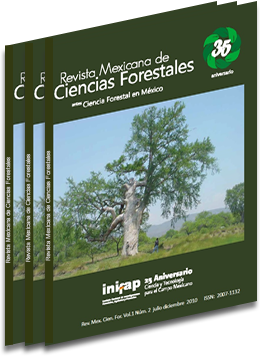ANCIENT TREES OF MEXICO
DOI:
https://doi.org/10.29298/rmcf.v1i2.634Keywords:
Baldcypress, old growth trees, riparian forests, conservation, ecosystems, ecotourismAbstract
Relict old growth forests in Mexico have almost disappeared, however old trees in mixed conifer forests are still present in remote mountain ranges which has allowed to determine their dominant phenotypes. A conifer species that lives for many years is Pseudotsuga menziesii thriving in the Western and Eastern Sierras Madre and the Eje Neovolcanico can surpass 600 years of age. This species is highly sensitive to climate and is frequently used for paleoclimatic studies. Other conifer species like Pinus cembroides, Pinus pinceana, Pinus culminicola, and Pinus lumholtzii growing in drier conditions reach ages over 300 years, but Pinus hartwegii an alpine species in the Mexican volcanoes can live over 600 years. Taxodium mucronatum, a riparian species, reaches the oldest age in Mexico and specimens over a thousand years old have been found in riparian ecosystems of the states of San Luis Potosi, Durango and Queretaro. On the other hand, tropical and semiarid ecosystems have not been fully studied for ancient trees. Some old specimens have been linked to historical events such as the Independence War and the Mexican Revolution situation that may contribute to their conservation. The location of old growth species provides additional knowledge to justify actions for the protection and restoration of degraded ecosystems, development of ecotourism projects and to protect biodiversity.
Downloads
Downloads
Published
How to Cite
Issue
Section
License
The authors who publish in Revista Mexicana de Ciencias Forestales accept the following conditions:
In accordance with copyright laws, Revista Mexicana de Ciencias Forestales recognizes and respects the authors’ moral right and ownership of property rights which will be transferred to the journal for dissemination in open access.
All the texts published by Revista Mexicana de Ciencias Forestales –with no exception– are distributed under a Creative Commons License Attribution-NonCommercial 4.0 International (CC BY-NC 4.0), which allows third parties to use the publication as long as the work’s authorship and its first publication in this journal are mentioned
The author(s) can enter into independent and additional contractual agreements for the nonexclusive distribution of the version of the article published in Revista Mexicana de Ciencias Forestales (for example, include it into an institutional repository or publish it in a book) as long as it is clearly and explicitly indicated that the work was published for the first time in Revista Mexicana de Ciencias Forestales.
For all the above, the authors shall send the form of Letter-transfer of Property Rights for the first publication duly filled in and signed by the author(s). This form must be sent as a PDF file to: ciencia.forestal2@inifap.gob.mx
This work is licensed under a Creative Commons Attribution-Noncommercial 4.0 International license.







